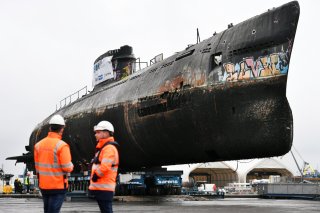Why A Nuclear-Armed Russian Submarine Is Sleeping On The Bottom Of The Bay Of Biscay
In an eternal slumber.
Here's What You Need To Remember: The loss of K-8 (along with the several accidents that afflicted her sisters) undoubtedly helped the Soviet Navy learn important lessons about distant operations, if only at extraordinary costs in human lives. And her nuclear torpedoes remain at the bottom, an enduring monument to most dangerous missions of the Cold War.
The Bay of Biscay is one of the world’s great submarine graveyards. In late World War II, British and American aircraft sank nearly seventy German U-boats in the Bay, which joined a handful of Allied and German subs sunk in the region during World War I. On April 12, 1970, a Soviet submarine found the same resting place. Unlike the others, however, K-8 was propelled by two nuclear reactors, and carried four torpedoes tipped by nuclear warheads.
The Novembers (627):
The November (Type 627) class was the Soviet Union’s first effort at developing nuclear attack submarines. The 627s were rough contemporaries of the Skate and Skipjack class attack boats of the U.S. Navy (USN), although they were somewhat larger and generally less well-arranged. Displacing 4750 tons submerged, the thirteen 627s could make thirty knots and carry twenty torpedoes (launched from eight forward tubes). Visually, the 627s resembled a larger version of the Foxtrot class diesel-electric subs; the Soviets would not adopt a teardrop hull until the later Victor class. The Novembers were renowned in the submarine community for their noise; louder than any contemporary nuclear sub, and even preceding diesel-electric designs.
The Novembers were initially designed with a strategic purpose in mind. The Soviets worked on a long-range nuclear armed torpedo (dubbed T-15), which could strike NATO naval bases from ranges of up to 40km. The torpedo was so large that each submarine could only carry a single weapon. However, increasingly effective Western anti-submarine technology quickly scotched the first mission. The Novembers were too loud to plausibly find their way into close enough proximity to a NATO port to ever actually fire a nuclear torpedo in wartime conditions.
The Soviet Navy (which did not have much interest in the strategic mission at that point) reconfigured the 627 class for a more conventional anti-ship role. Despite their noisiness, the Novembers had the range to threaten NATO surface vessels, especially transport convoys. A small number of nuclear torpedoes (configured with smaller warheads compatible with conventional torpedoes) could wreak havoc on such a convoy, despite the likely loss of the sub to any surviving escorts. The 627s were never regarded as particularly effective sub hunters, in part because they were louder than any foreign contemporaries, and in part because of deficient sonar technology.
K-8:
K-8, the third November boat, entered service in the Soviet Northern Fleet in late 1960. In one of her first cruises, she suffered a coolant incident that almost resulted in the loss of the ship; many of her crew members were exposed to high levels of radiation. Drastic action saved the boat, and she returned to port for repairs.
In early spring 1970, K-8 participated in the Okean 70 naval wargame, an exercise intended to display the reach of the Soviet Navy, as well as to work out problems associated with operations distant from Soviet bases. This exercise was enormous; the largest the Soviet Navy had ever undertaken, and really the biggest naval operation that the Russians had attempted since the ill-fated transfer of the Baltic Fleet to the Pacific in the Russo-Japanese War. Ships from the Northern, Baltic, Black Sea, and Pacific fleets participated, roughly two hundred in all. The Soviet Northern Fleet deployed sixty surface ships and forty submarines in support of the operation. As per normal procedure, K-8 was carrying four torpedoes armed with nuclear warheads.
On April 8, K-8 suffered two fires, resulting in a shutdown of both nuclear reactors. The boat surfaced, and Captain Vsevolod Borisovich Bessonov ordered the crew to abandon ship. Eight crew members, trapped in compartments that were either flooded or burned out, died in the initial incident. Fortunately, a Soviet repair vessel arrived, and took K-8 under tow. However, bad weather made the recover operation a difficult prospect. Much of K-8’s crew reboarded the submarine, and for three days fought a life-and-death struggle to save the boat. Although details remain scarce, there apparently was no opportunity to safely remove the four nuclear torpedoes from K-8, and transfer them to the repair ship.
Unfortunately, the loss of power onboard and the difficult weather conditions were too much for the crew to overcome. On April 12, K-8 sank with some forty crew members aboard, coming to rest at a rough depth of 15,000 feet. The depth made any effort at recovering the submarine, and the nuclear torpedoes, impractical.
K-8’s mission was similar to that of the German U-boats she shares the bottom with: the severing of the trans-Atlantic lifeline that kept the United States connected with Western Europe. She used different weapons and could operate at greater ranges than those boats, but her core purpose was the same. Later on, Soviet submarines would adopt a variety of different mission profiles, from anti-submarine warfare to cruise missile launch to (eventually) land attack. The loss of K-8 (along with the several accidents that afflicted her sisters) undoubtedly helped the Soviet Navy learn important lessons about distant operations, if only at extraordinary costs in human lives. And her nuclear torpedoes remain at the bottom, an enduring monument to most dangerous missions of the Cold War.
Robert Farley, a frequent contributor to TNI, is author of The Battleship Book. He serves as a Senior Lecturer at the Patterson School of Diplomacy and International Commerce at the University of Kentucky. His work includes military doctrine, national security, and maritime affairs. He blogs at Lawyers, Guns and Money and Information Dissemination and The Diplomat.
Image: Reuters.
This first appeared several years ago.

